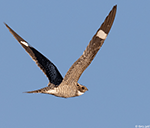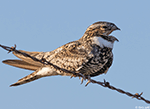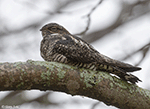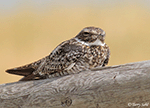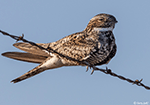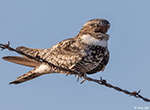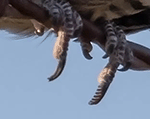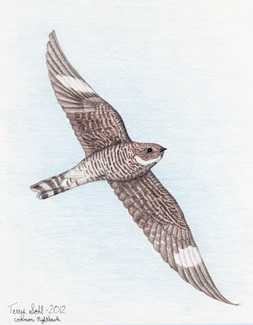| Length: 9 to 10 inches | Wingspan: 20 to 22 inches | Seasonality: Summer |
| ID Keys: In flight, slender, long sharply pointed wings, white bar near base of primaries | ||
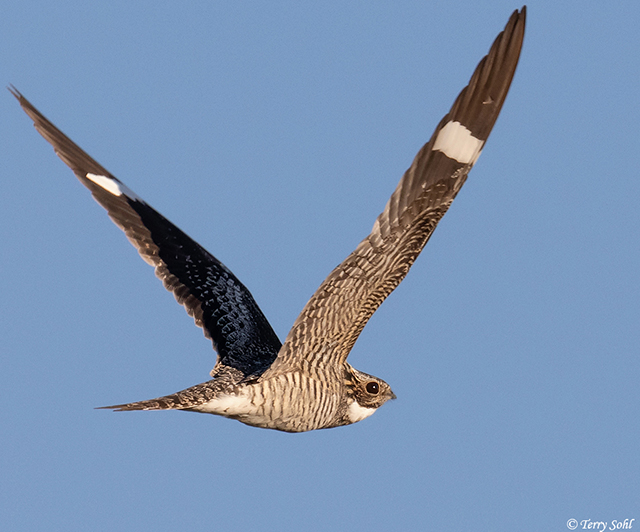 The Common Nighthawk is a familiar sight on summer evenings in the state as it is
often seen over urban areas as it chases flying insects. They are highly
specialized for capturing insects in flight, with a mouth that opens to a truly
enormous size compared to the size of the bird. Active during
both the day or night, they often congregate around light sources at night to
feed on swarming insects. Common Nighthawks can sometimes be soon roosting
during the day, typically single birds found on horizontal tree branches, fence
posts, or rocks. The species has adapted very well to a human
presence, and will often nest on gravel roofs.
The Common Nighthawk is a familiar sight on summer evenings in the state as it is
often seen over urban areas as it chases flying insects. They are highly
specialized for capturing insects in flight, with a mouth that opens to a truly
enormous size compared to the size of the bird. Active during
both the day or night, they often congregate around light sources at night to
feed on swarming insects. Common Nighthawks can sometimes be soon roosting
during the day, typically single birds found on horizontal tree branches, fence
posts, or rocks. The species has adapted very well to a human
presence, and will often nest on gravel roofs.
Note one unusual feature of the Common Nighthawk is a "pectinate" toe (see photos at bottom of the page). The comb-like extension on one toe of a nighthawk is thought to function as a grooming device, combing and preening feathers and perhaps removing parasites.
Habitat:
Can be found in a wide variety of semi-open to open habitats, including farmland, prairies, forest clearings, and urban areas.
Diet:
Insects, especially flying insects such as moths, grasshoppers, beetles, flies, and flying ants.
Behavior:
May feed at any time of the day or night, but is often the most active near dawn and dusk. Common Nighthawks have incredibly wide, gaping mouths which are used to scoop up insects in flight.
Nesting:
June and July in South Dakota. The nest is usually on the ground in a sandy or pebbly location, but they have also learned to use gravel and rock roofs in urban areas. The female lays 2 eggs directly on the nesting surface, with no formal nest constructed. Both parents help to incubate the eggs, but the female does most of the incubation. Upon hatching, both parents help feed the young regurgitated insects.
Song:
The typical call of a Common Nighthawk is a nasal, harsh "peent", given either in flight or while at rest. Common Nighthawks are also known for 'Booming", a loud, harsh, buzzy noise produced by the air moving through their wings as they dive during courtship flights.
- Click here to hear the loud buzzy "boom" of a Common Nighthawk interspersed with typical calls.1
- Click here to hear another audio recording with calls interspersed by a wing boom.2
Migration:
Summers throughout most of the U.S. and Canada. Primarily winters in South America.
Interactive eBird Map:
Click to access an interactive eBird map of Common Nighthawk sightings
Similar Species:
Similar overall in structure to other "goatsuckers" that could be found in South Dakota
- Chuck-wills Widow - Chuck-will's Widow are typically a species of further south and east in the US, but in the early 2000s, the species was found occasionally nesting as far north and west as the Pierre area. Despite their rarity, they and Common Nighthawks could potentially both be found in the same location in South Dakota. Habitat, however, is one clue if a resting bird is found, as Chuck Will's Widow are found in forested areas, while Common Nighthawks prefer open habitats with rocky or gravelly areas for nesting. Chuck Will's Widow are also nocturnal birds, rarely making a daytime appearance, as Common Nighthawks often do. In flight, Chuck Will's Widow lack the characteristic white bar under the wings that's found on Common Nighthawk.
- Common Poorwill - Common Poorwills are another goatsucker species that's more common in South Dakota than Chuck-Will's-Widow, with good populations in the western part of the state. They are most commonly seen at night, as a drive along a gravel road may reveal a pair of glowing eyes reflected in the headlight as they strike a bird sitting on the roadside. They prefer dry habitats and could potentially be found in conjunction with Common Nighthawks. They have a distinctive "poor-will!" call that distinguishes them from the harsher squawks of Common Nighthawk. In terms of appearance, Common Poorwills lack the white bar on the underside of a Common Nighthawk's wings, and have white on the tip of the tail.
- Eastern Whip-poor-will - Eastern Whip-poor-wills are another goatsucker species that can be found in South Dakota. Range and habitat are one clue for differentiating them from Common Nighthawks. Eastern Whip-poor-will are only (typically) found in the far southeastern part of South Dakota, and are typically found in dense deciduous forest habitats, as opposed to more open habitats for Common Nighthawks. Eastern Whip-poor-will aren't typically active during the daytime as Common Nighthawks often are, and lack the white bars under the wings of a Common Nighthawk.
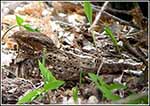 |
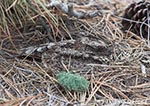 |
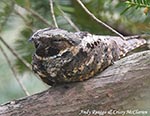 |
| Chuck-will's Widow | Common Poorwill | Eastern Whip-poor-will |
Conservation Status:
Common throughout much of its range, but in some locations has exhibited severe declines for unknown reasons. However, populations currently aren't under a serious threat, and the IUCN lists the Common Nighthawk as a species of "Least Concern".
South Dakota "Hotspot":
Common Nighthawks could be seen almost anywhere in open habitats during the summer months, but one place I seem to see them more consistently than elsewhere in the state is Buffalo Gap National Grasslands. Even more reliable for one specific locations is the Sioux Falls airport! There have been many times where I've gotten back from a business trip in the late evening or after dark, walked out of the building, and immediately heard the calls of foraging Common Nighthawks. As noted above, Common Nighthawks will nest on a rocky roof, and I suspect some buildings in the airport area must have that feature.
Further Information:
Image Information:
June 28th, 2020 - Near Wind Cave National Park, South Dakota - Terry Sohl
Audio File Credits:
- 1Bruce Lagerquist - Recorded in Chelan County, Washington on June 10th, 2017. Original recording and information from xeno-canto.
- 2Sunny - Recorded near Sayres Lake, Canada on August 4th, 2019. Original recording and information from xeno-canto.
| Click on the map below for a higher-resolution view |
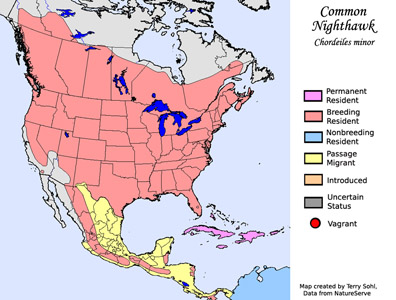 |
| South Dakota Status: Common summer resident throughout the state. |
Additional Common Nighthawk Images
Click for a higher-resolution version of these photos
